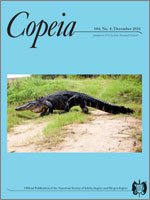Squamate reptiles have highly developed chemosensory systems used to detect both predators and prey. Although the general ability of squamates to assess predation risk using chemical cues is well known, the detail to which squamates can make discriminations concerning risk is largely unexamined. Granite Night Lizards (Xantusia henshawi) are habitat specialists that live in exfoliations of granite boulders in dense populations. We measured the responses of Granite Night Lizards to the scent of a sympatric predator, the Lyre Snake (Trimorphodon lyrophanes), maintained on two different diets (lizard-fed and mouse-fed), as well as a non-predatory snake (the Shovelnose Snake, Chionactis occipitalis) and a blank control. We also evaluated the potential use of conspecific chemical cues to assess predation risk by quantifying the response of lizards to the scent of both calm and stressed conspecifics. We collected scents for both experiments on paper pads, which we then placed at the entrance of a shelter within a testing arena containing a focal lizard. We then used video cameras to record the behavior of focal lizards over a 60-minute period. We found that, compared to the blank control, Night Lizards in the presence of chemical cues from snakes took longer to enter the shelter, spent longer investigating chemical cues, and traveled further before entering the shelter. Lizards also spent longer investigating chemical cues from Lyre Snakes than Shovelnose Snakes. However, there were no significant differences between responses to lizard-fed and mouse-fed Lyre Snake chemical cues. We also found no evidence that lizards use conspecific chemical cues to evaluate predation risk. This study demonstrates that Granite Night Lizards can use chemical cues from their predators to assess predation risk, but further research is needed to assess whether these responses differ based on the diet of the predator.
How to translate text using browser tools
16 December 2016
The Use of Chemical Cues by Granite Night Lizards (Xantusia henshawi) to Evaluate Potential Predation Risk
Laura E. Kabes,
Rulon W. Clark
ACCESS THE FULL ARTICLE





